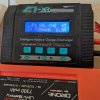First, I was not using the Zippy as a preferred example, just one that I grabbed quickly, so the rest is not important.
I understood you, mate, but just those two types of batteries were making the argument I wanted to make. Although the numbers on the paper are the same, the quality varies quite a bit from one to the other when the weight tells us that it is better to take the lightest one. That's where I wanted to go.
LiHV cells have become popular because they offer more power for the same C rating due to a higher starting voltage. I use them in my F5J planes and they simply perform better than normal lipos for the same C rating.
No doubt, but I was referring to the difference in weight for the same energy capacity, or in other words, with the same weight a LIPO and a Li-ion, a Li-ion is able to store more energy. On the other hand, it is not able to deliver more energy at any given time, have less C discharge. This in an airplane that has much less needs than a multirotor is very good, but for a multirotor, unless very specific cases, is not a viable option. I wish it could be an option because we would get higher flight times with the same weight. And here we are talking about the H520 which is a multirotor. The fixed wing is another world, which has a lot in common with the multirotors, but this is not the case.
All we're talking about are conjectures, my intention was to draw attention to those users who have less experience than you may have, or me (which I'm sure is less) and not just look at the total capacity of the battery, there are many more factors to take into account. Not only with this battery I doubt the data given by the manufacturer, with the new H520 RTK I also doubt them until I see contrasted reviews. The same thing happens to me that with these batteries, the numbers are too good and this based on the most used or purchased in the market with a quality contrasted. Time will tell, or you may confirm it for us

So I plan to grab a couple, see what they weight and assess how they perform. Only then can an actual determination of their performance and value be supported.
And here we will all be delighted that you share your impressions of these batteries, me first

P.D.: It's nothing personal, mate. We can even agree to disagree

As I always say, I hope that my kindergarten English will allow you to understand what I mean, because I know it's not always like that, sorry.





